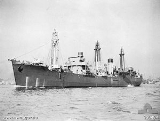
HMAS Bungaree
Encyclopedia
HMAS Bungaree was an auxiliary minelayer
Minelayer
Minelaying is the act of deploying explosive mines. Historically this has been carried out by ships, submarines and aircraft. Additionally, since World War I the term minelayer refers specifically to a naval ship used for deploying naval mines...
of Royal Australian Navy
Royal Australian Navy
The Royal Australian Navy is the naval branch of the Australian Defence Force. Following the Federation of Australia in 1901, the ships and resources of the separate colonial navies were integrated into a national force: the Commonwealth Naval Forces...
(RAN), serving during World War II. The ship was built as a cargo vessel for the Adelaide Steamship Company
Adelaide Steamship Company
The Adelaide Steamship Company was formed by a group of South Australian businessmen in 1875. Their aim was to control the transport of goods between Adelaide and Melbourne and profit from the need for an efficient and comfortable passenger service...
by Caledon Shipbuilding & Engineering Company
Caledon Shipbuilding & Engineering Company
The Caledon Shipbuilding & Engineering Company, Limited was a British shipbuilding company based in Dundee on the east coast of Scotland.-History:...
at Dundee
Dundee
Dundee is the fourth-largest city in Scotland and the 39th most populous settlement in the United Kingdom. It lies within the eastern central Lowlands on the north bank of the Firth of Tay, which feeds into the North Sea...
, and launched in 1937. The ship operated in Australian waters and was requisitioned by the RAN in October 1940. Decommissioned on 7 August 1946 and returned to her owners on 5 November 1947, she was sold in 1957 and renamed Dampier. She was then sold in 1960 and renamed Eastern Mariner and while operating in South Vietnamese waters she struck a mine on the Saigon River and was sunk on 26 May 1966.
Acquisition
The civilian merchant freighter Bungaree was requisitioned by the RAN in October 1940, and was commissioned into the RAN on 9 June 1941 after being converted into a minelayer. Following her conversion, HMAS Bungaree had a capacity of 423 naval mineNaval mine
A naval mine is a self-contained explosive device placed in water to destroy surface ships or submarines. Unlike depth charges, mines are deposited and left to wait until they are triggered by the approach of, or contact with, an enemy vessel...
s and was originally armed with two 4 inches (101.6 mm) guns for protection. She was later modified to carry 467 mines.
Operational history
Bungaree laid her first minefield off Port MoresbyPort Moresby
Port Moresby , or Pot Mosbi in Tok Pisin, is the capital and largest city of Papua New Guinea . It is located on the shores of the Gulf of Papua, on the southeastern coast of the island of New Guinea, which made it a prime objective for conquest by the Imperial Japanese forces during 1942–43...
in August 1941 and, as Australia's only minelayer, laid over 10,000 mines in defensive minefields in Australian and New Zealand
New Zealand
New Zealand is an island country in the south-western Pacific Ocean comprising two main landmasses and numerous smaller islands. The country is situated some east of Australia across the Tasman Sea, and roughly south of the Pacific island nations of New Caledonia, Fiji, and Tonga...
waters during World War II. Bungaree was present in Sydney Harbour during the Japanese midget submarine attack
Attack on Sydney Harbour
In late May and early June 1942, during World War II, submarines belonging to the Imperial Japanese Navy made a series of attacks on the cities of Sydney and Newcastle in New South Wales, Australia...
on 31 May 1942.
As the Allies moved onto the offensive the need for defensive minefields lessened, with Bungaree re-tasked as a survey ship from January 1944 and a store ship from August 1944.
Bungaree was awarded the battle honour
Battle honour
A battle honour is an award of a right by a government or sovereign to a military unit to emblazon the name of a battle or operation on its flags , uniforms or other accessories where ornamentation is possible....
"Pacific 1942-43" for her wartime service.
Decommissioning and fate
HMAS Bungaree was decommissioned on 7 August 1946 and was returned to her owners on 5 November 1947. The mines she laid in Australian waters were swept by the RANRoyal Australian Navy minesweeping after World War II
Following World War II the Royal Australian Navy was required to clear naval mines from the waters around Australia and New Guinea. Minesweeping in these areas began in December 1945 and was completed in August 1948...
between 1945 and 1948. She was sold in 1957 and renamed Dampier. She was sold again in 1960 and renamed Eastern Mariner and while operating in South Vietnamese waters she struck a mine on the Saigon River and sank on 26 May 1966.

